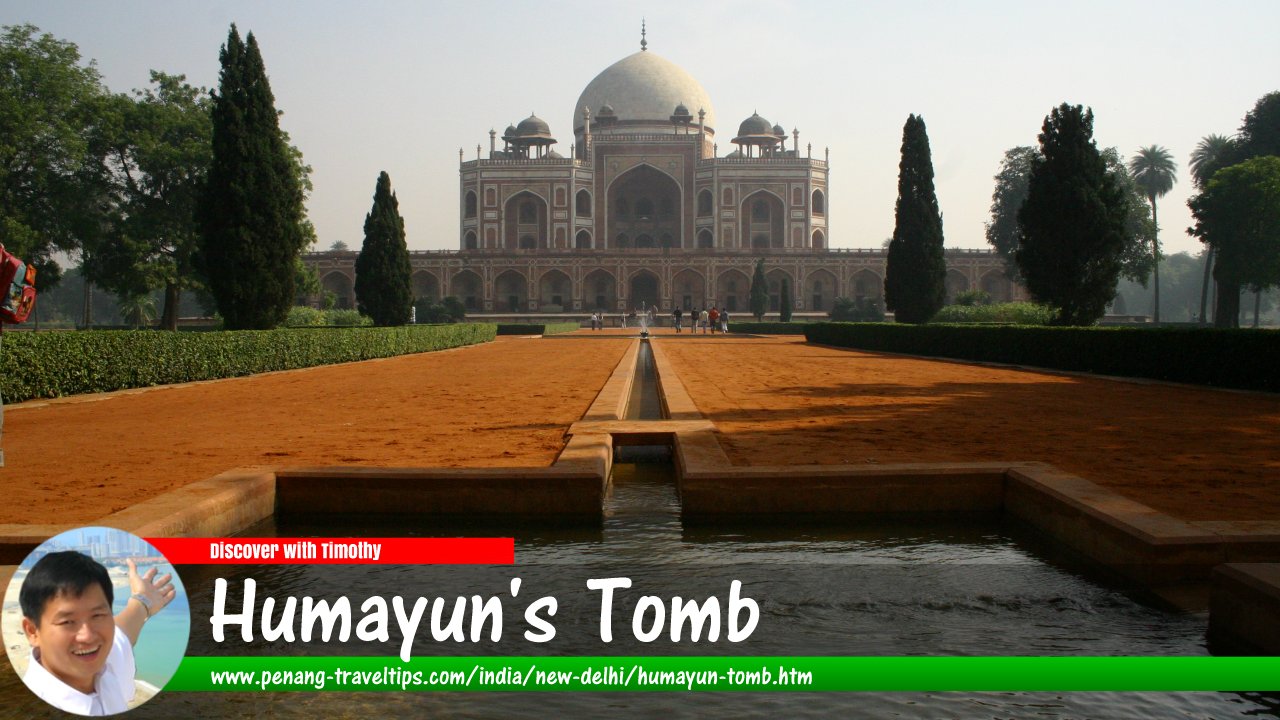 View of Humayun's Tomb from its watercourses. (19 November, 2004)
View of Humayun's Tomb from its watercourses. (19 November, 2004) Humayun's Tomb (GPS: 28.59273, 77.25092) is a major historic tomb on Mathura Road in New Delhi. It is one of two sites in New Delhi that have been recognized by UNESCO as World Heritage Sites. Humayun's Tomb is located near Lodi Road. High rubble walls enclose a square garden that is divited into four large squares, separated by causeways and channels. Each square is then divided again by pathways into smaller squares. These are called Chaharbagh, and is typical of Mughal design.
Humayun's Tomb (GPS: 28.59273, 77.25092) is a major historic tomb on Mathura Road in New Delhi. It is one of two sites in New Delhi that have been recognized by UNESCO as World Heritage Sites. Humayun's Tomb is located near Lodi Road. High rubble walls enclose a square garden that is divited into four large squares, separated by causeways and channels. Each square is then divided again by pathways into smaller squares. These are called Chaharbagh, and is typical of Mughal design.
The Man in the Tomb
Humayun the Fortunate (1508-1556) was the eldest son of Babur, the founder of the Mughal Dynasty. He had three younger brothers, Kamran, Askari and Hindal. He was born on March 6, 1508, in Kabul, where he learnt Turkish, Arabic and Persian at a very young age. He assisted his father in the governance of the country. In 1520, he was appointed the Governor of Badakshan at the age of 12 years. When Babur invaded India in 1526, Humayun joined him with a contingent from Badakshan.He won a maiden victory in this campaign. He also led contingents under his father's rule against various Afghan insurgents, as well as participated in the battle of Kanwaha. After Babur's death in 1530, he was chosen as the successor. Humayun ascended the throne in Agra on December 30, 1530, at the age of 23, four days after his father's death.
Inscription Details
Location: N28 35 36.0 E77 15 02.0Inscription Year: 1993
Type of Site: Cultural
Inscription Criteria: II, IV Humayun inherited an empire barely held together by force of arms. It lacked a consolidated civil administration. He faced numerous problems right from the start, from the Afghan nobles, from the Rajputs, and most of all from his own brothers who were mean and disloyal to him. Unable to judge the growing power of Sher Shah, Humayun was defeated in the battle of Kanauj in 1540. He became a fugitive and escaped to Iran via Sindh.
While in Sindh, he married a young Persian girl, Hamida Bano, who joined him in his wanderings. A year later in Umerkot in upper Sindh, his first son Akbar was born. According to legend, Humayun had nothing to give to his followers on this happy occasion except some musk. The musk was broken into pieces and passed among his men. He is reported to have said that one day the fame of the prince would spread like the smell of the musk.
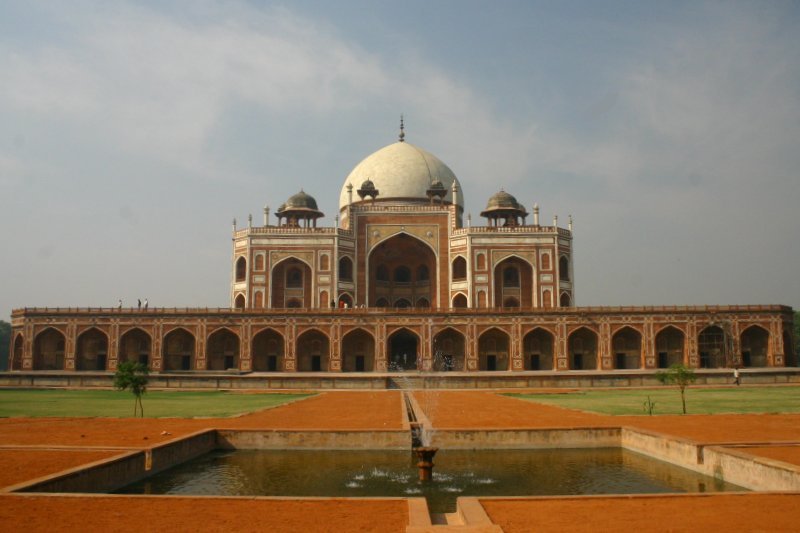 Closer view of the mausoleum built by Humayun's widow.(19 November, 2004)
Closer view of the mausoleum built by Humayun's widow.(19 November, 2004)
For a period of 15 years, the Mughal Empire lay dormant while Sher Shah founded the Suri Dynasty. However, in 1555 Humayun returned again, and by his sheer perseverance, was able to recover his kingdom. But his reign was cut short by a tragic event. In January 1556, he slipped on the steps of the Din Panah Fort and died. His son Akbar succeeded him as the third emperor of the Mughal Dynasty. Although lacking his father's abilities, Humayun was a cultivated gentleman with broad knowledge of the science of astrology and mathematics. Mild and benevolent in character, he was very kind towards his brothers; and despite their treachery, forgave them repeatedly. He also possessed a very charitable and magnificent personality. Although Humayun had recovered his kingdom, he was not destined to rule it for long.
The Tomb of Humayun
Humayun's lofty mausoleum is located in the centre of the Bu Halima Enclosure and rises from a podium faced with a series of cells with arched openings. The central octagonal chamber containing the cenotaph is encompassed by octagonal chambers at the diagonals and arched lobbies on the sides, their openings closed with perforated screens.Three arches dominate each side with the central one being the highest. This plan is repeated on the second storey, and a 42.5m high double dome of marble surmounts the roof with pillared kiosks (called 'chatris') placed around it. The structure is built with red sandstone, but white and black marble are used to relieve the monotony, the latter largely in the borders.
The tomb was built by Humayun's senior widow Bega Begam, popularly known as Haji Begam, nine years after his death in 1565 according to some, but fourteen years according to the manuscript of an 18th century text. The architect was Mirak Mirza Ghiyas from Persia. It is the first substantial example of Mughal architecture for tombs, with high arches and double dome, which occurs here for the first time in India. Although some tombs had already been sited within gardens, Humayun's Tomb is also the first mature example of the idea of garden-tomb, which culminated in the Taj Mahal at Agra which was built by Humayun's great grandson Shah Jahan.
The enclosure is entered through two lofty double-storeyed gateways, one on the west and the other on the south, the latter now remaining closed. A 'baradari' (pavilion) occupies the centre of the eastern wall of the enclosure and a bath-chamber that of the northern wall.
In addition to Humayun, several rulers of the Mughal dynasty were buried in the mausoleum, although it is not possible to identify them by their graves. Among these are Bega Begam, Hamida Banu Begam - Humayun's junior wife, Dara Shikoh - Shah Jahan's son, and the later Mughals, Jalandar Shah, Farrukhsiyar, Rafi'u'd-Darajat, Rafi'u'd-Daula and 'Alamgir II, Bahadur Shah II, the last Mughal emperor of Delhi who had taken shelter in this tomb with the three princes during the mutiny and was captured here in 1857 by Lieutenant Hodson.
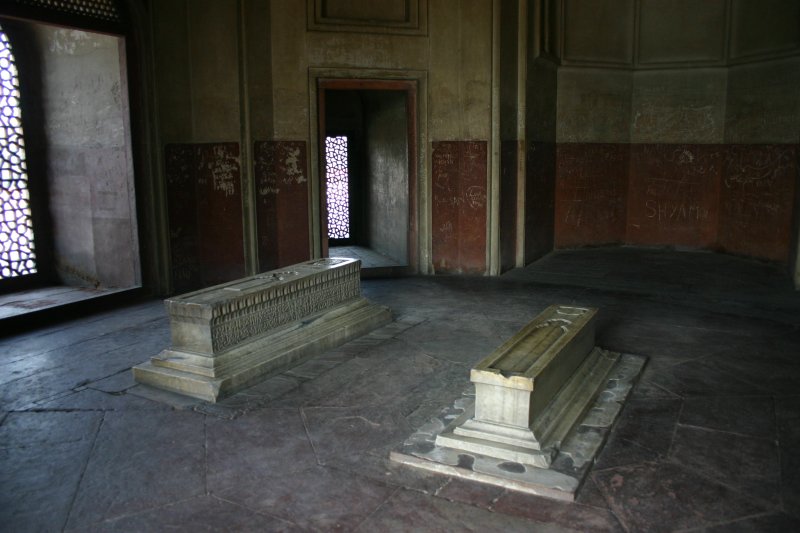 Many of Humayun's relatives are also buried within the mausoleum. (19 November, 2004)
Many of Humayun's relatives are also buried within the mausoleum. (19 November, 2004)
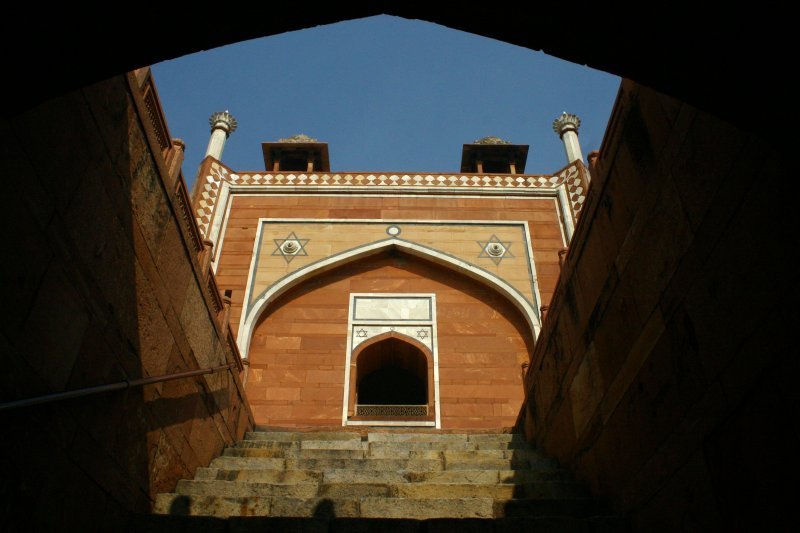 Steps leading to the mausoleum. (19 November, 2004)
Steps leading to the mausoleum. (19 November, 2004)
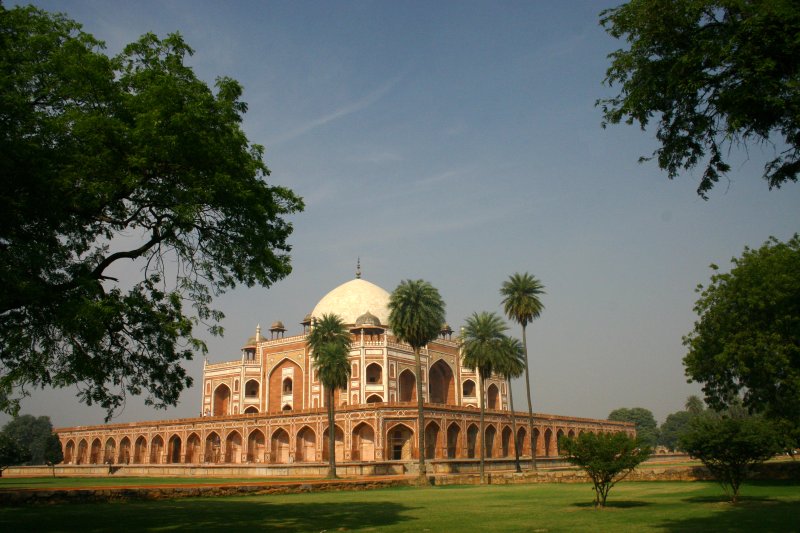 A vision of Islamic paradise: Humayun's Tomb in a formal garden. (19 November, 2004)
A vision of Islamic paradise: Humayun's Tomb in a formal garden. (19 November, 2004)
Humayun's Tomb is  on the Map of New Delhi, India
on the Map of New Delhi, India
List of Mausoleums in New Delhi and Mausoleums in India
 Latest updates on Penang Travel Tips
Latest updates on Penang Travel Tips

Copyright © 2003-2025 Timothy Tye. All Rights Reserved.

 Go Back
Go Back